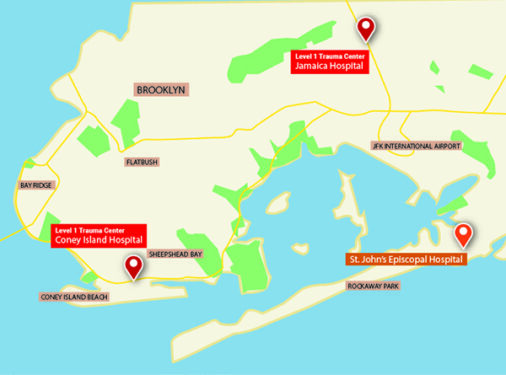
Long rides for the most injured locals
PROSPECT HEIGHTS — It’s not something Rockaway Peninsula residents like to think about — but the question is always there. In a worst case scenario — a serious car accident, for example — where is the closest trauma center to which an ambulance can transport victims?
The answer to the 115,000 people living on the Queens peninsula should be disturbing: There are no trauma centers anywhere on the 11-mile-long strip.
The fact that there isn’t a trauma center capable of handling victims of car accidents, shootings, stabbings and other major calamities is raising concerns among residents, community leaders and elected officials.
There is one facility in the area, St. John’s Episcopal Hospital, a 257-bed medical facility with an emergency department that handles approximately 44,000 cases a year. The ER was expanded in 2020, increasing it in size from 10,000 square feet to 21,000 square . But it is not a trauma center.
The difference between an emergency room and a trauma center is this: while the ER can deal with a variety of medical issues, including heart attacks and strokes, a trauma center can handle traumatic injuries, such as gunshot or stab wounds, or the kind suffered in serious car accidents.
Patients suffering traumatic injuries on the peninsula are transported to the closest Level 1 trauma center, Jamaica Hospital in Queens — approximately 8-10 miles away.
If there’s a traffic jam, precious time is lost. “They usually take people to Jamaica Hospital on the Van Wyck (Expressway). When has the Van Wyck ever not been crowded? There’s not too many days when it flows freely,” said Mike Long, who lives in Breezy Point, on the peninsula’s westernmost end.
When a 22-year-old off-duty police officer was shot by suspects trying to steal his car on Beach Channel Drive on Feb. 1, he was taken in a patrol car to Jamaica Hospital.
In some cases, patients are taken all the way to Coney Island Hospital in Brooklyn, which, like Jamaica Hospital, is a Level 1 trauma center. Both Jamaica and Coney Island Hospitals are connected to the Rockaway Peninsula by bridges.
“It’s amazing that with an area this size, there’s only one hospital,” said Father Bill Sweeney, pastor of St. Francis de Sales Church in Belle Harbor. He noted that the peninsula includes among its residents large numbers of cops and firefighters who are married to nurses, and added, “They are familiar with health care. They know it can’t go on like this.”
According to residents, the solution is simple: either build a new hospital somewhere on the peninsula so that there are two hospitals serving the public or upgrade St. John’s Episcopal to a trauma center. St. John’s Episcopal Hospital officials say they are willing for the facility to step up in status.
“We have committed to do a study to evaluate what level of trauma certification we can acquire and will share that with our local elected officials in hopes they can support with the funding that we will need to make that happen,” said Renee Hastick-Motes, vice president of external affairs.
The certification for a new trauma unit will take city and state approval, neither of which appears to be forthcoming. Neither the city nor the state Departments of Health responded to interview requests from The Tablet.
Councilwoman Joann Ariola, a Republican who represents the peninsula, said elected officials are on board with the idea of a new hospital.
“There is a need for it. There are elected officials who are both on the state and city level that are interested in seeing that happen. But we don’t want to see St. John’s Episcopal not get the proper funding that it needs. We want to enhance what’s already there,” she said.
Queens Community Board 14, which covers the peninsula, has been advocating for a solution for years.
It isn’t just that there’s no trauma center. The fact that there’s only one hospital on the entire peninsula is significant because it translates into longer wait times in the ER at St. John’s Episcopal, officials said.
“St. John’s is doing the best they can, but the emergency room is often very overcrowded,” said Board 14 District Manager Jonathan Gaska.
Hastick-Motes said the overcrowding is real but does not adversely affect healthcare. “Are there times our emergency room is busy? Absolutely, like other hospitals throughout the city. We have created innovative ways to help manage emergency room visits,” she added.
The peninsula used to have a second hospital, but the state closed Peninsula Hospital in 2012.
It was one of dozens of hospitals across the state targeted for restructuring or closing by the Berger Commission, a blue-ribbon panel appointed by then-Governor George Pataki in 2005 to streamline the delivery of healthcare. The commission issued its recommendations in 2006.
A decade after its shutdown, the loss of Peninsula Hospital is still being felt.
When Firefighter Jesse Gerhard collapsed in his Far Rockaway firehouse, Ladder 134, on Feb. 16, a day after he and his colleagues battled a two-alarm blaze on Beach Channel Drive, he was rushed to St. John’s Episcopal — two miles away from the firehouse — where he was pronounced dead. Ladder 134 is located around the corner from the site where Peninsula Hospital once stood.
When Board 14 recently voted to approve a plan for a housing development at the former Peninsula Hospital site, it requested that a trauma center also be built there.
The health care discussion comes at a time when plans for development on the peninsula are moving forward — bringing with it the prospect of more people coming to live there.
“The city is continually approving more affordable housing units. We’re talking at this point around 11,000 units over the next three years. So that’s probably about another 30,000 people,” Gaska said. “And our hospital is not getting any bigger.”
